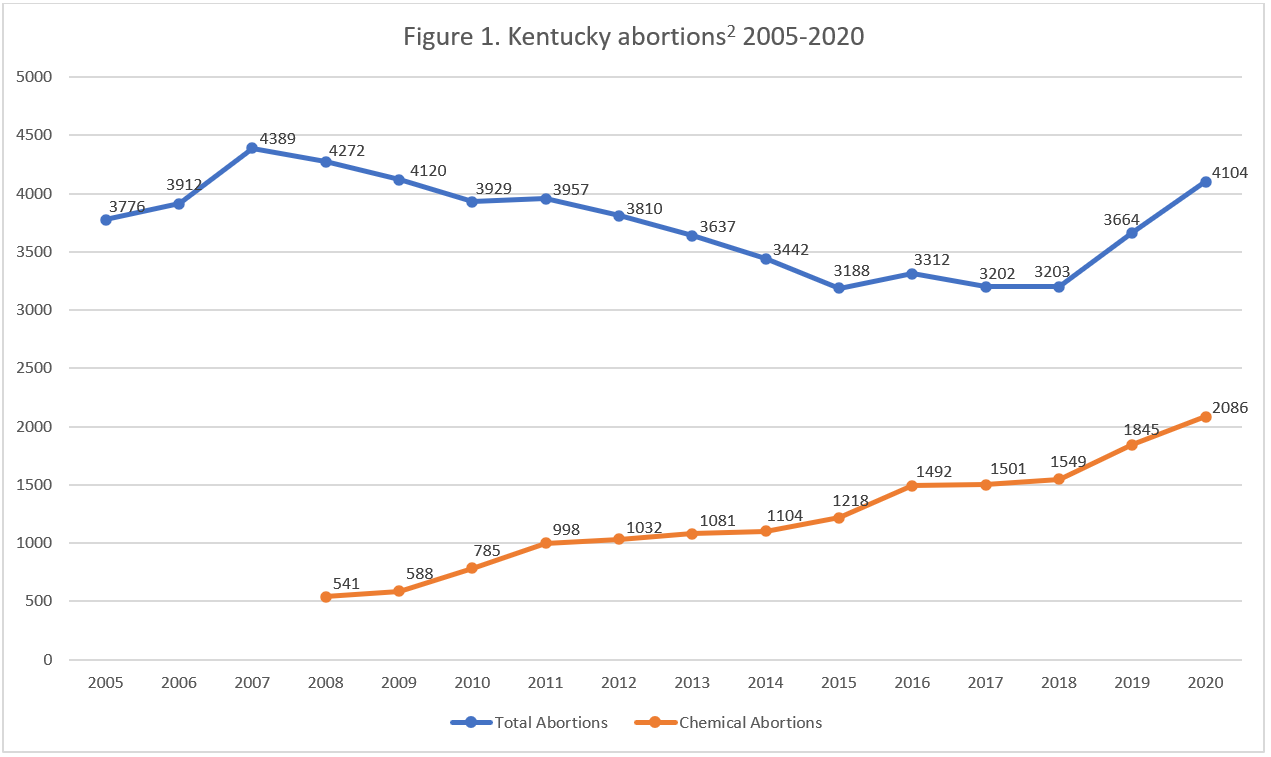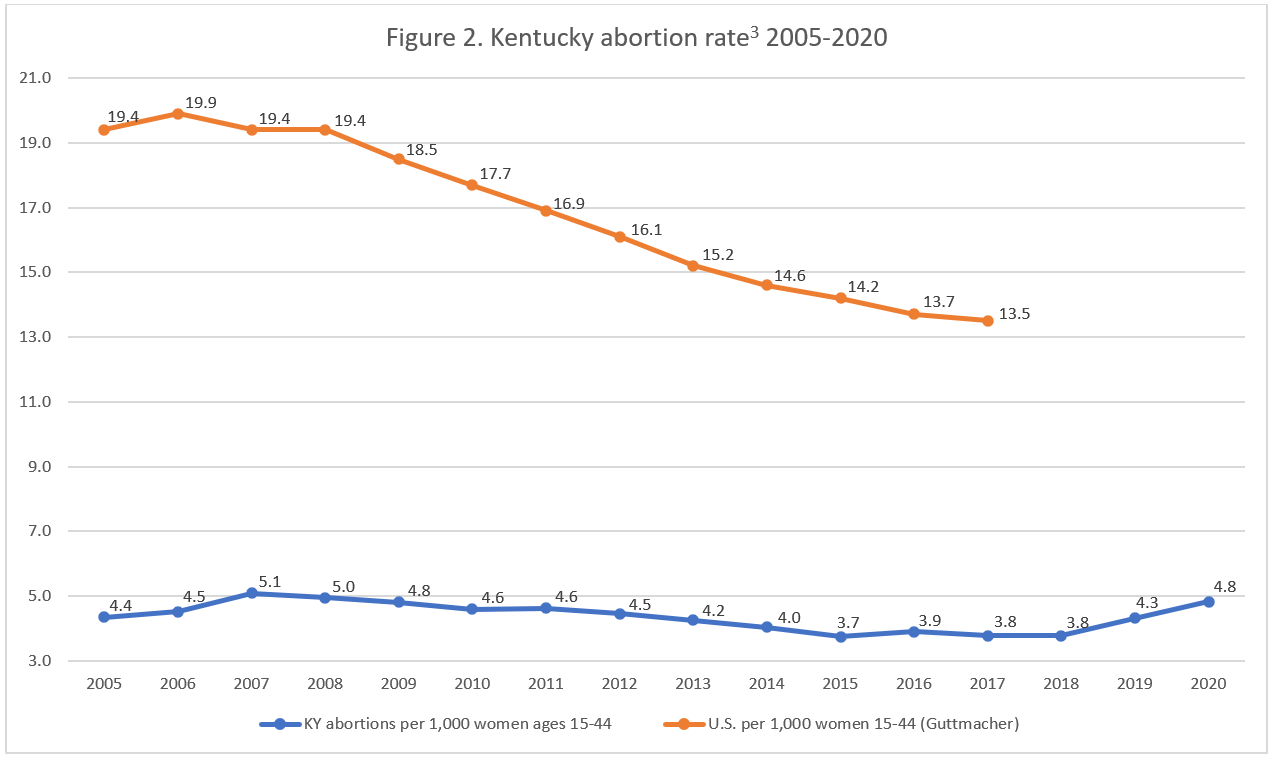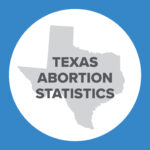Abortion Reporting: Kentucky (2020)
Kentucky’s 2020 abortion report was published by the Kentucky Cabinet for Health and Family Services in September 2021. The report was the fourth to be published online.
Statistics and Changes in Kentucky Abortions, 2019-2020

Abortion Totals and Trends
There were 4,104 abortions reported in Kentucky in 2020, a 12 percent increase from the previous year and the first time since 2009 that over 4,000 abortions were reported in the state (Fig. 1). Chemical abortions rose 13 percent, composing 51 percent of the total in 2020. The Charlotte Lozier Institute (CLI) estimates that Kentucky’s 2020 abortion rate was 4.8 abortions per 1,000 women of childbearing age, much lower than the national rate but up 12 percent from 2019 (Fig. 2). As of March 2022, 29 states had released 2020 abortion statistics, of which 19 showed that abortions increased from the previous year.
State Report Summary
In 2020, 85 percent of the abortions reported in Kentucky were on state residents, and 15 percent were obtained by women from other states, including 10 percent on women from Indiana and four percent on women from Tennessee. Kentucky abortions performed on state residents increased by 15 percent from 2019, while abortions performed in Kentucky on nonresidents declined by four percent.
Nine percent of Kentucky abortions were performed on girls ages 19 and younger. Twenty-nine percent were obtained by women ages 20 to 24, and 30 percent were performed on women ages 25 to 29. An additional 29 percent of the abortions were conducted on women in their thirties, and three percent were performed on women ages 40 and older.
Just over half of Kentucky abortions (54 percent) were performed on white women. Thirty-five percent were performed on black women, and five abortions (0.1 percent) were obtained by American Indian women. Eleven percent of the abortions were on women of other races, while race was not reported for six abortions. Ninety-two percent of Kentucky abortions were on non-Hispanic women, and eight percent were on Hispanic women. CLI estimates that Kentucky’s black abortion rate was 16.3 abortions per 1,000 women ages 15 to 44, more than five times the white rate (3.0 abortions per 1,000 women ages 15 to 44).
Forty-six percent of the abortions were obtained by women with 12 years of education or fewer, while a majority (54 percent) were on women who had completed one to four years of college. Three abortions were performed on women who had finished five or more years of college. Eighty-seven percent of Kentucky abortions were performed on unmarried women, compared to 13 percent on married women.
Thirty-four percent of the abortions reported in Kentucky were performed on women with no previous live births. Twenty-seven percent were on women with one prior live birth, and 40 percent were on women with two or more births. Sixty-five percent were obtained by women who reported no previous abortions, 23 percent were on women with one previous abortion, and 12 percent were on women with more than one prior abortion. Twenty-one percent of Kentucky abortions were performed on women who had previously had a miscarriage.
Half the abortions reported in Kentucky in 2020, 51 percent, were chemical abortions. One of these was an abortion induced after 20 weeks using Cytotec (a brand name for misoprostol). Additionally, one abortion was reported as “Other/Abortion Drug,” and the person filling out the form specified that the drug used was Cytotec. Forty-nine percent of the abortions were surgical, with 42 percent performed via suction curettage and seven percent conducted using dilation and evacuation. One abortion was performed using sharp curettage.
Four percent of Kentucky abortions occurred between four and five weeks of gestation, jumping to 28 percent at six weeks. Thirty-four percent were performed between seven and eight weeks of gestation, and fourteen percent were reported between nine and 10 weeks. Seven percent occurred between 11 and 12 weeks of gestation, six percent between 13 and 15 weeks, and five percent between 16 and 19 weeks. There were 43 abortions (one percent) at 20 weeks of gestation and 35 abortions (not quite one percent) at 21 weeks of gestation and later.
Kentucky limits abortion at 20 weeks post-fertilization unless the mother’s life or a major bodily function is at risk. In 2020, one abortion was reported after 20 weeks post-fertilization (at 23 weeks post-fertilization), and the physician certified that the abortion was medically necessary. The physician also certified that the abortion procedure chosen gave the unborn baby the best chance of survival; the abortion was performed using Cytotec. The report does not indicate whether the unborn baby survived.
Kentucky’s 2020 abortion report was the first to include information on abortion complications. More than one complication could be reported for each abortion. In 2020, 30 abortions were reported to have resulted in complications. There were 18 incomplete abortions and two cases of heavy bleeding that resulted in hypovolemia or a blood transfusion. There was one cervical laceration, one uterine laceration, one failed abortion, and one other adverse event. Additionally, there were six abortions in which the reporting form indicated that complications had occurred but did not specify the type of complication.
The vast majority of Kentucky abortions, 91 percent, were performed at EMW Women’s Surgical Center in Louisville. Nine percent occurred at Planned Parenthood’s Louisville center, the first Planned Parenthood abortions reported in Kentucky since 2016. Nine abortions were reported by the University of Louisville, and one each was reported by Norton Hospital, Norton Women’s and Children’s Hospital, and University of Kentucky Health Care. January had the highest abortion total (367 abortions), and November had the lowest (285).
Planned Parenthood in Kentucky
For several years, Planned Parenthood of Louisville’s applications for a license to perform abortions were denied and the center did not perform abortions. However, with a change in state administration in late 2019, Planned Parenthood was invited to apply for a license and the center now performs abortions once more. Also in 2019, Planned Parenthood of Indiana and Kentucky, the affiliate that operates the Louisville center, announced it was merging with Planned Parenthood of the Great Northwest and Hawaiian Islands in order to benefit from the latter affiliate’s better fundraising and favorable political environment. The merger was finalized in April 2021.
State Ranking
In a CLI report evaluating abortion reporting across the country, Kentucky was ranked at 43rd best, but the Bluegrass State has made improvements since then. Kentucky now requires abortion providers to report complications, and the state’s abortion reports are made available online. Kentucky could continue to improve its reporting by requiring all health care providers, including emergency rooms, to report abortion complications they treat.


- Statistics on abortion complications reported here represent a minimal number of deaths and complications, as this data is collected in a non-systematic and non-verifiable way. As such, this data cannot be used to calculate either an accurate abortion mortality rate or an accurate abortion complication rate for the state.
- Kentucky published reports for 2017 through 2019 online and provided CLI with reports for 2015 through 2018. Abortion totals for 2005 through 2014 were taken from the annual abortion surveillance reports published by CDC. Kentucky first reported chemical abortion data to CDC in 2008.
- Rates were calculated by CLI using the following formula: (total number of abortions performed in Kentucky ÷ number of resident women ages 15-44) x 1,000. Rates may differ slightly from previous CLI articles due to revised population estimates. Population estimates were obtained from the CDC WONDER database.

























